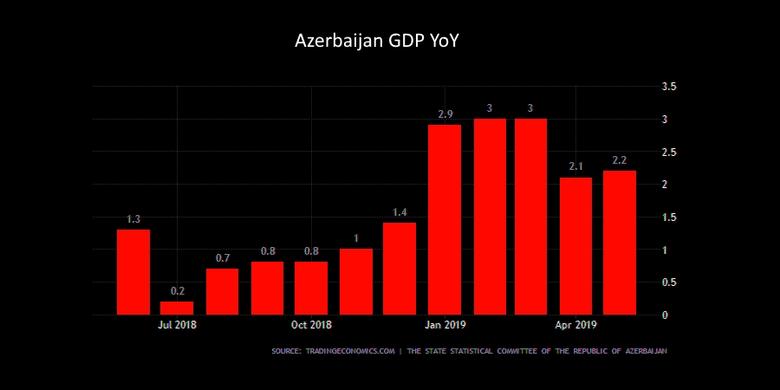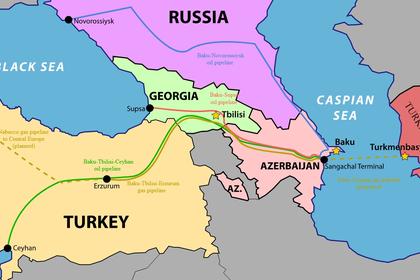
AZERBAIJAN'S GDP UP 2.7%

IMF - IMF Staff Completes 2019 Article IV Mission to Azerbaijan
- Gradual and growth-friendly consolidation would help to share exhaustible oil wealth with future generations and strengthen buffers to deal with future shocks. Recent social measures will provide a stimulus to the economy and should help to protect the most vulnerable.
- Moving towards inflation targeting, together with continued strengthening of financial sector oversight, would improve risk management and foster the development of financial markets.
- Continued reforms to ease the business environment and improve policy frameworks, governance, and transparency are essential to enhance prospects for diversified, private-sector led, and inclusive growth.
An International Monetary Fund (IMF) team led by Ms. Natalia Tamirisa visited Azerbaijan during June 12–27, 2019, to conduct discussions for the 2019 Article IV Consultation. Upon conclusion of the visit, Ms. Tamirisa issued the following statement:
“A gradual economic recovery is underway. Recent increases in wages, pensions, and social assistance; and measures to reduce tax and debt burdens are expected to boost nonoil growth to 2.7 percent over the near term. Hydrocarbon production will surge this year as the Southern Gas Corridor pipeline becomes operational, before settling on a lower yet stable growth path. Inflation is projected at 3.3 percent over the near term. The fiscal surplus will rise to 5.8 percent of GDP this year, mainly due to higher hydrocarbon revenues, and remain broadly stable next year. The current account surplus is projected to exceed 10 percent of GDP in the near term.
“Continued fiscal consolidation would help save an adequate portion of the exhaustible oil income for future generations while using “good” times to build buffers for “rainy” days. In this context, the government’s introduction of the fiscal rule in 2019 was a major step forward. It now needs to be complemented by stronger public financial management, better fiscal transparency, and management of fiscal risks. A gradual pace of consolidation, together with steps to improve the efficiency of public spending and rebalance its composition toward growth-friendly investment in physical and human capital, would help mitigate any adverse impact on the economy. Close oversight of state-owned enterprises (SOEs) and the financial sector would help manage large contingent fiscal liabilities.
“Continued monetary easing appears appropriate, given still tight financial conditions and remaining spare capacity. Transitioning to inflation targeting, as the Central Bank of Azerbaijan recently announced, would help to absorb shocks and encourage better risk management. Together with steps to modernize monetary operations and increase issuance of local currency securities, it would foster financial market development, facilitate financial sector liquidity management, provide a benchmark for corporate bonds and a risk-free investment for the private sector. Tackling high non-performing loans, upgrading financial sector regulations and strengthening financial sector supervision are essential to improve confidence and prevent a build-up of future vulnerabilities.
“Improving medium-term growth and job prospects and diversifying the economy require deepening and broadening structural reforms aimed at increasing the role of the private sector and improving governance and transparency. The authorities’ recent steps to improve the World Bank’s Doing Business Indicators need to be complemented by efforts to restructure SOEs, promote competition, and improve procurement and access to finance. Enhancing the quality of education and healthcare would help to nurture a more productive workforce. Social measures should be well-targeted. Continued improvement of economic policy frameworks and institutions would help to align policies with the authorities’ vision of private sector-led, diversified and inclusive economic growth.
“The IMF team would like to express its appreciation to the authorities and other stakeholders for their hospitality and candid and insightful discussions.”
|
Azerbaijan: Selected Economic Indicators |
||||
|
Projections |
||||
|
2017 |
2018 |
2019 |
2020 |
|
|
Output |
||||
|
Real GDP growth (in percent) |
-0.3 |
1.4 |
2.7 |
2.1 |
|
Real non-oil GDP growth (in percent) |
2.4 |
1.8 |
2.8 |
2.7 |
|
Real oil GDP growth (in percent) |
-4.4 |
0.6 |
2.5 |
1.2 |
|
Employment |
||||
|
Unemployment rate (in percent) |
5.1 |
... |
... |
... |
|
Prices |
||||
|
Consumer price index (period average) |
12.8 |
2.3 |
3.2 |
3.3 |
|
General government finances |
||||
|
Revenue (including grants, in percent of GDP) |
34.2 |
38.8 |
39.9 |
39.0 |
|
Expenditure (in percent of GDP) |
35.6 |
33.1 |
34.1 |
34.0 |
|
Current expenditure |
25.3 |
19.1 |
22.5 |
25.2 |
|
Capital spending and net lending |
10.3 |
14.1 |
11.6 |
8.8 |
|
Fiscal balance (in percent of GDP) |
-1.4 |
5.6 |
5.8 |
5.1 |
|
Non-oil primary fiscal balance (in percent of non-oil GDP) |
-30.9 |
-32.1 |
-31.0 |
-30.2 |
|
General government gross debt (direct borrowing) |
22.5 |
18.8 |
19.2 |
17.9 |
|
General government gross debt including guarantees |
53.2 |
48.4 |
50.3 |
46.2 |
|
Money and credit |
||||
|
Broad money (including foreign currency deposits, percentage change) |
9.0 |
11.3 |
7.2 |
6.0 |
|
Bank credit to the private sector (percentage change) |
-28.1 |
14.9 |
6.8 |
8.2 |
|
Balance of payments |
||||
|
Current account balance (in percent of GDP) |
4.1 |
12.9 |
10.4 |
10.9 |
|
Foreign direct investment (in percent of GDP) |
0.7 |
-1.7 |
4.8 |
4.5 |
|
Gross international reserves (in months of non-oil imports) |
5.1 |
4.7 |
5.7 |
6.0 |
|
Exchange rate |
||||
|
REER (average, percentage change) |
3.3 |
5.6 |
… |
… |
|
Sources: Azerbaijani authorities; and IMF staff estimates and projections. |
||||
-----
Earlier:













